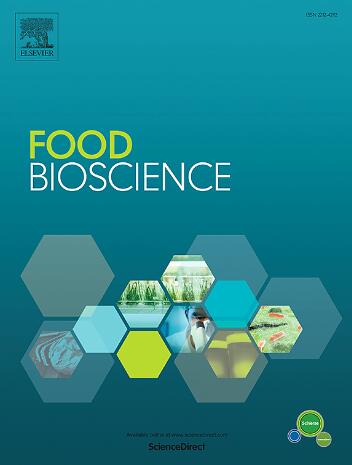Chemical structures, antioxidant capacities, and immunostimulatory activities of pectic polysaccharides from jujube fruits collected from different producing areas
IF 4.8
1区 农林科学
Q1 FOOD SCIENCE & TECHNOLOGY
引用次数: 0
Abstract
Pectic polysaccharides are well-recognized as the mainly functional components in jujube fruits, which have garnered considerable attentions to be exploited into functional food products. Nevertheless, the knowledge about the influence of the producing area on their fine structural features and biological functions is still scarce, which may restrict their rational use in the functional food sector. Therefore, the structural and biological properties of pectic polysaccharides from jujube fruits (JP) collected from different producing areas were compared. The results showed that JP's physicochemical properties (e.g., total uronic acids, total bound polyphenols, molecular mass distributions, and ratios of constituent monosaccharides) varied significantly depending on the producing area. However, the primary chemical structures of JPs obtained from various producing areas were largely similar, predominantly composing of homogalacturonan and rhamnogalacturonan-I regions. Furthermore, JP's antioxidant and immunostimulatory effects also varied remarkedly depending on the producing area, primarily attributed to variations in their physicochemical properties. Particularly, JP's antioxidant activity demonstrated a significantly positive correlation with the levels of total uronic acids and total bound polyphenols, and similarly, its immunostimulatory activity was highly dependent on the level of total uronic acids. Moreover, mechanistic investigations revealed that JP could enhance immune responses via activating the Toll-like receptor 4 mediated nuclear factor-κB signaling pathway in RAW 264.7 macrophages. Collectively, the current findings could provide valuable insights for the rational application of jujube fruits and JP in the functional food sector.
不同产地枣果胶多糖的化学结构、抗氧化能力及免疫刺激活性
果胶多糖是枣类水果中公认的主要功能性成分,其在功能性食品中的应用受到广泛关注。然而,有关产地对果胶多糖精细结构特征和生物功能影响的知识仍然匮乏,这可能会限制果胶多糖在功能食品领域的合理利用。因此,本研究比较了不同产地的枣果实(JP)中果胶多糖的结构和生物特性。结果表明,JP 的理化性质(如总尿酸、总结合多酚、分子质量分布和组成单糖的比例)因产地不同而存在显著差异。不过,不同产区的 JP 的主要化学结构基本相似,主要由均半乳糖醛酸和鼠李糖半乳糖醛酸-I 区域组成。此外,JP 的抗氧化和免疫刺激作用也因产地不同而存在显著差异,这主要归因于其理化性质的不同。特别是,JP 的抗氧化活性与总尿酸和总结合多酚的水平呈显著正相关,同样,其免疫刺激活性也高度依赖于总尿酸的水平。此外,机理研究表明,JP 可通过激活 RAW 264.7 巨噬细胞中由 Toll 样受体 4 介导的核因子-κB 信号通路来增强免疫反应。总之,目前的研究结果可为枣果和 JP 在功能食品领域的合理应用提供有价值的见解。
本文章由计算机程序翻译,如有差异,请以英文原文为准。
求助全文
约1分钟内获得全文
求助全文
来源期刊

Food Bioscience
Biochemistry, Genetics and Molecular Biology-Biochemistry
CiteScore
6.40
自引率
5.80%
发文量
671
审稿时长
27 days
期刊介绍:
Food Bioscience is a peer-reviewed journal that aims to provide a forum for recent developments in the field of bio-related food research. The journal focuses on both fundamental and applied research worldwide, with special attention to ethnic and cultural aspects of food bioresearch.
 求助内容:
求助内容: 应助结果提醒方式:
应助结果提醒方式:


